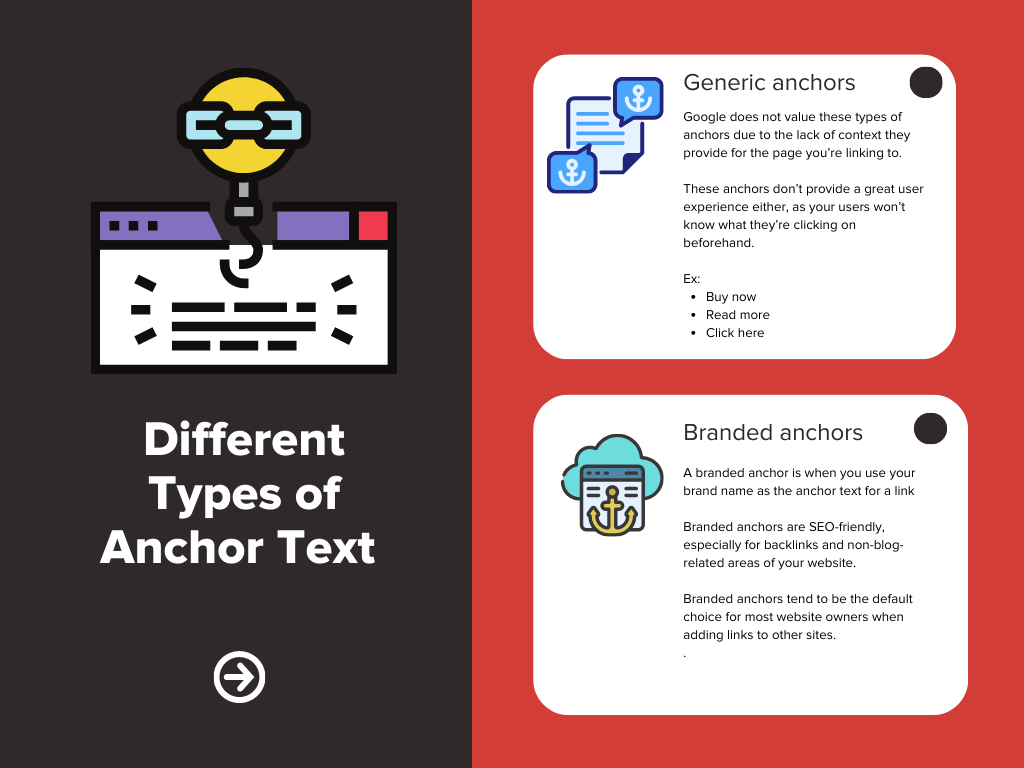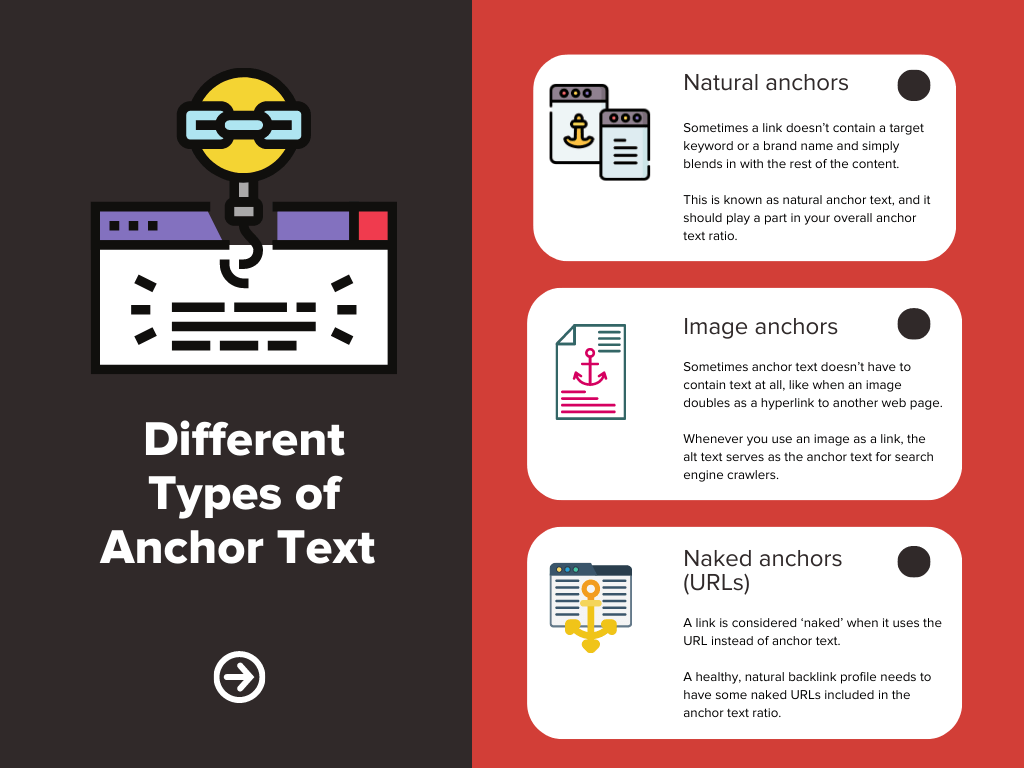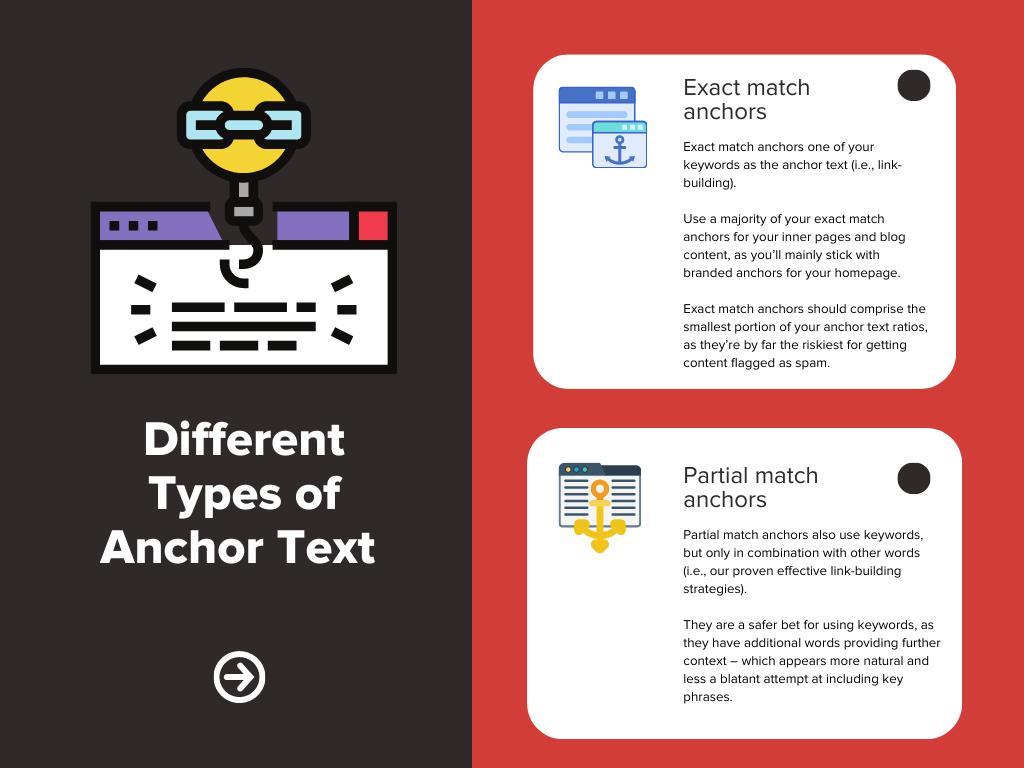What do backlinks, internal links, and external links all need to have the best possible impact on your link profile?
If you guessed optimized anchor text, then you’re 100% correct.
Both established and new SEOs tend to overlook optimizing their anchor text, as they’re too focused on acquiring as many backlinks as possible.
Yet, anchor text is a ranking factor, as it provides valuable context to search engines about the web pages your links point to.
Moreover, anchor text ratios are equally as important to establishing a ‘natural-looking’ link profile.
What are those?
Anchor text ratios refer to the percentage of anchor text types you use throughout your homepage and inner pages.
Believe it or not, there’s in-depth strategizing involved in choosing the type of anchor text you use for every internal link, external link, and backlink.
Options include using exact matches for your keywords (i.e., link building), partial match key phrases (i.e., link-building is essential), your brand name (i.e., The HOTH), and more.
How do we know this works?
Here at The HOTH, we’ve conducted extensive research into top-ranked Google results from countless industries to discover what a #1 ranking link profile looks like.
We were able to determine undeniable similarities in the anchor text ratios of top-ranked Google results.
In other words, we uncovered the magic ratios for achieving top-tier backlink profiles, so read on to learn how to master anchor text optimization for your website.
Understanding Anchor Text
Anchor text refers to the words that comprise a hyperlink.
For example, if we wanted you to check out our Rankings Drop Guide (hint: we do), we would insert a hyperlink to it (like we did).
As you can see, the text rankings drop guide is ‘anchored’ to a hyperlink to our blog post covering common Google rankings drop issues.
Anchor text applies to any type of link, including internal, external, and backlinks.
Sometimes links don’t contain any special text and use the bare URL as the link (i.e., www.thehoth.com), which are known as ‘*****’ links.
While it’s easy not to think too much about anchor text since it seems so basic, it actually plays a big role in your SEO (and user experience).
In fact, your anchor text is how search engines understand the context of A) the page you’re linking to and B) how it relates to the web page containing the link.
Not only that, but anchor text also provides much-needed context for your users.
For instance, let’s say that you want to link to a related blog post in one of your articles. If you don’t provide context for it through anchor text, it will confuse your readers – as they won’t know why it’s there or where it leads.
Here’s an example:
Gardening is an excellent hobby that anyone can enjoy (click here), which is why we’ve put together this beginner’s guide.
The anchor text here is far too generic and doesn’t provide any context, which is why optimized anchor text matters for search engines and users.
Google’s History with Anchor Text Ratios
In the early days of Google, less importance was placed on ‘natural-looking’ backlink profiles.
As a result, anchor text containing target keywords was the most powerful – causing many SEOs to spam their anchors with keywords.
The tactic provided impressive results, too, as keyword-rich anchor text often led to stellar rankings.
That all changed in 2012 when Google rolled out one of its most infamous algorithm updates, Penguin.
It was one of Google’s first attempts at ridding their search results of keyword spam, and it was enormously effective.
Nearly overnight, SEOs relying on keyword-rich anchor text saw their rankings come crashing down in a big way.
In the eyes of Google, spammy keyword anchors only served to game their algorithm – leading to high rankings for websites that weren’t necessarily of the highest quality (or relevant to user search queries).
Ever since Penguin, SEO has been all about making your backlink profile appear as natural as possible.
Hence, the need for utilizing anchor text ratios came about.
Instead of relying solely on keyword-rich anchor text, websites need to mix things up with different types of anchors. An example would be blending partial match anchors, brand anchors, and exact match keyword anchors.
That way, your backlink profile will appear ‘natural’ to Google, as on paper – it looks like you acquired links from lots of different sources without trying to game the system.
As stated in the intro, we’ve rigorously researched the top-ranked Google backlink profiles to determine the picture-perfect anchor text ratio.
Before we get to that, it’s essential to understand the different types of anchor text that are viable for SEO.
Understanding the Different Types of Anchor Text
There are numerous ways you can go about writing anchor text, and not all of them are good for your SERP rankings.
However, sticking to one type of anchor text isn’t a good idea either, as it’ll make your link profile appear unnatural to Google.
Here’s a look at the different types of anchor text you can use to create your anchor text ratio.

Generic anchors
First, let’s look at the type of anchor that you should NEVER use for anchor text that you want to help your SEO.
Generic anchors are basic phrases like:
- Buy now
- Read more
- Click here
- Go here
- Act now
- This website
- This page
- This one
Google does not value these types of anchors due to the lack of context they provide for the page you’re linking to.
These anchors don’t provide a great user experience either, as your users won’t know what they’re clicking on beforehand.
While generic anchors can sometimes work when combined with the CTA at the end of blog posts, your best bet is to avoid them – especially if you want your anchor text to affect your SEO positively.
Branded anchors
A branded anchor is when you use your brand name as the anchor text for a link.
In our case, a branded anchor would look like this:
Visit The HOTH to learn more about our expert white-label digital marketing services.
Branded anchors are SEO-friendly, especially for backlinks and non-blog-related areas of your website.
In fact, most of the backlinks you acquire naturally will probably use branded anchors, as it tends to be the default choice for most website owners when adding links to other sites.
This is where a catchy and well-known brand name will really help you out, as some of the most recognizable companies (think big names like Best Buy, Amazon, and Apple) get loads of backlinks just by others mentioning and linking to their brand.
Another perk is that branded anchors appear very natural to Google, so using them is always a safe bet.

Natural anchors
Sometimes a link doesn’t contain a target keyword or a brand name and simply blends in with the rest of the content.
This is known as natural anchor text, and it should play a part in your overall anchor text ratio.
Why include anchors that don’t provide any value to your SEO strategy?
While it may seem counterproductive to not include at least one keyword in the anchor text, sometimes your best bet is to refrain.
Remember, your #1 goal is to build a natural backlink profile that doesn’t scream over-optimization.
That’s why you need to include natural anchors along with branded and keyword anchors – as it’ll keep your link profile squeaky clean.
Strategically, it makes the most sense to include natural anchors whenever there’s no relevant keyword that applies to the link without sounding awkward or forced. You should also use natural anchors when it doesn’t make sense to use your brand name.
Pro tip: Just because you aren’t using keywords doesn’t mean you can’t provide much-needed context to search engines through natural anchors. Ensure that you write anchor text that provides a preview of what you’re linking to, as it’s best to avoid generic phrases even when writing natural anchors.
Image anchors
Sometimes anchor text doesn’t have to contain text at all, like when an image doubles as a hyperlink to another web page.
Whenever you use an image as a link, the alt text serves as the anchor text for search engine crawlers.
Since crawler bots lack computer vision, they won’t be able to see any images that you include in your content. The alt text lets them know what the image displays, as well as how it relates to your content (if you wrote it properly, that is).
You should include the web page’s target keyword in the alt text, as well as a brief description of what the image shows.
Including an occasional image-based link can be good for your anchor text ratios; just remember to include alt text.
***** anchors (URLs)
As mentioned previously, a link is considered ‘*****’ when it uses the URL instead of anchor text.
A healthy, natural backlink profile needs to have some ***** URLs included in the anchor text ratio, so don’t forget to use them.
Exact match anchors
Now we’re getting into anchors that use your target keywords. Exact match anchors one of your keywords as the anchor text (i.e., link-building).
You’ll want to use a majority of your exact match anchors for your inner pages and blog content, as you’ll mainly stick with branded anchors for your homepage.
Remember not to go too crazy with exact match anchors, as that’s what wrecked the rankings of countless websites whenever Penguin dropped way back in 2012.
In fact, exact match anchors should comprise the smallest portion of your anchor text ratios, as they’re by far the riskiest for getting content flagged as spam.
Partial match anchors
These anchors also use keywords, but only in combination with other words (i.e., our proven effective link-building strategies).
Partial match anchors are a safer bet for using keywords, as they have additional words providing further context – which appears more natural and less a blatant attempt at including key phrases.
What are Ideal Anchor Text Ratios?
Now that you’re well-versed in the different types of anchor text, it’s time to learn how to form the perfect anchor text ratio for your website.
There is no one-size-fits-all ratio that works for every web page, as you’ll want to use unique ratios for your homepage, blog content, and inner pages.
To determine these ideal ratios, we looked at the link profiles for thousands of #1-ranked results on Google. It took countless hours of research, but we uncovered undeniable similarities in the anchor text ratios for top-ranked results.
Here’s a look at our findings.
Homepage anchor text ratio
If you want your homepage to be as SEO-friendly as possible, here’s the anchor text ratio that you should strive for:
- 80% – 95% of your links should feature branded anchors, URLs, and natural anchor text.
- Only 10% of your links should contain partial match anchors.
- 5% or less of your homepage links should have exact match anchors.
Branded anchors, ***** URLs, and natural anchors should almost entirely dominate your homepage strategy.
That’s the best way to boost your SEO profile and appear natural to Google’s crawlers.
The proof?
Here’s a look at the anchor text ratio of Overstock.com’s homepage – one of the most notorious online retail companies.

As you can see, their homepage’s anchor text ratio follows our recommendation of primarily using branded, natural, and URL anchors while ignoring anchors containing keywords (they even have 0% exact match anchors).
Inner page anchor text ratio
By inner pages, we mean your blog content, landing pages, and product pages. These pages are where you should use the most keywords in your anchors while still using discretion.
Here’s the anchor text ratio we recommend for your inner pages:
- 35% – 45% of your links should contain branded, URL, or natural anchors.
- 50% – 60% should contain partial match anchors.
- No more than 10% of your links should include exact match anchors.
Even on your inner pages, you should use exact match anchors sparingly, so stick with partial matches whenever possible.
Closing Thoughts: Anchor Text Ratios
If you want to reach the top of the Google SERPs, your backlink profile needs to contain the right anchor text ratios.
The last thing you want is to see your rankings tank because you used too many exact match anchors, so ensure that you’re strategic when writing anchor text.
The ratios found in this article come from thousands of hours of real-world research, and they’re based on link profiles that Google feels are natural and high value.
Do you need help forming a link-building strategy (including anchor text ratios) for your business?
Then you need to check out our Link Outreach and Link Insertion Services from The HOTH. Our link-building experts will help you dominate the SERPs for your niche, so don’t wait to get in touch today.

